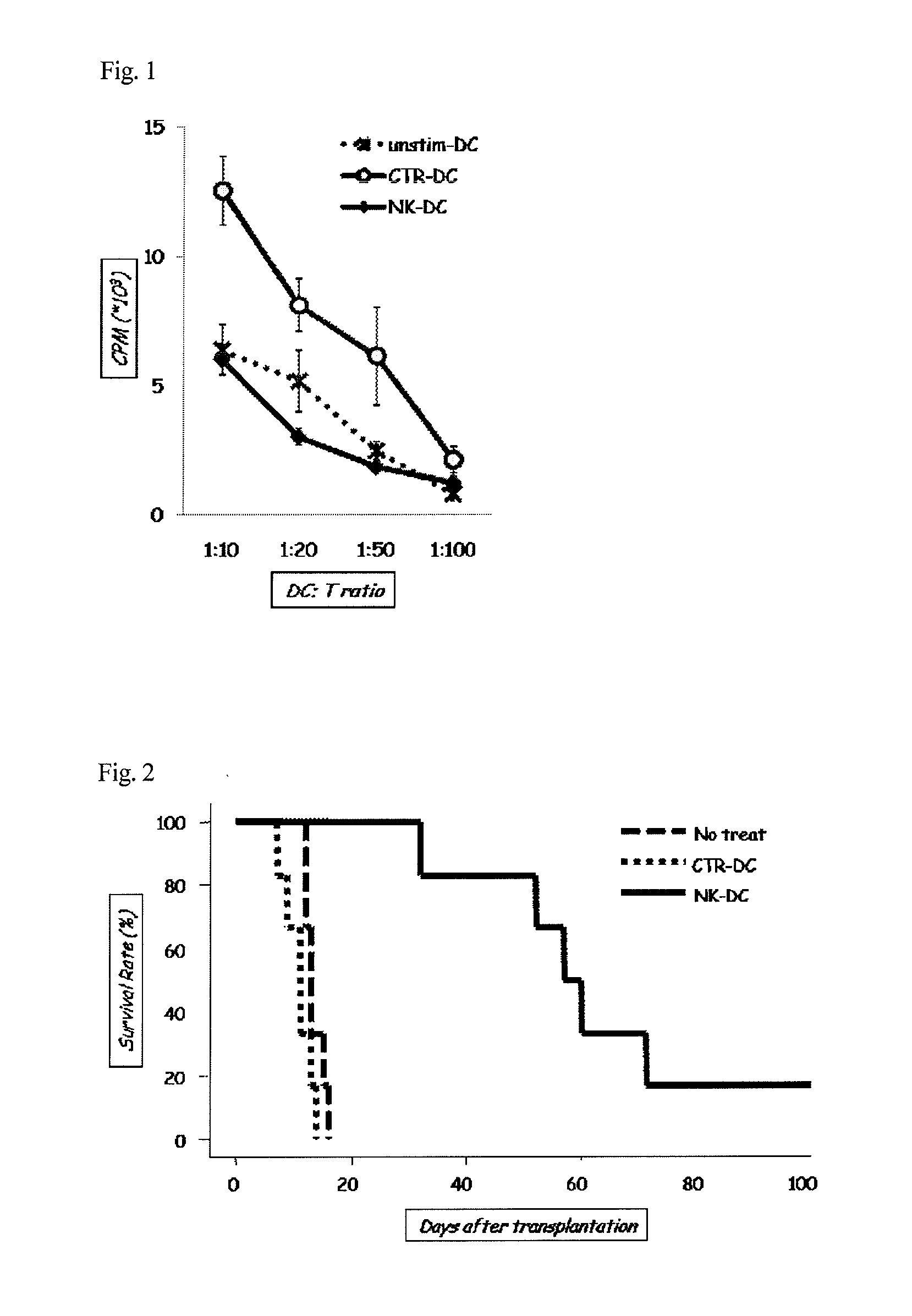Method for preparing regulatory dendritic cells
a dendritic cell and dendrite technology, applied in the direction of antibacterial agents, immunological disorders, drug compositions, etc., can solve the problems of reducing patient qol, adverse effects, halting administration, etc., and achieves low cost, high production efficiency, and high safety.
- Summary
- Abstract
- Description
- Claims
- Application Information
AI Technical Summary
Benefits of technology
Problems solved by technology
Method used
Image
Examples
example 1
[0071]The BALB / c mouse-derived spleen cell extract was added to dendritic cells derived from bone marrow cells which were collected from the C57BL / 6 mouse, thereby causing cells to present a BALB / c antigen. The effect of incorporating the BALB / c antigen was confirmed by measuring the expression of 1-Ad (antibody: BD pharmingen), which is a BALB / c major histocompatibility complex (MHC), by flow cytometry. At this time, cells were cultured in the presence or the absence of NK026680, and the cells were allowed to mature with TNF-α (Peprotech, origin: rabbit). Maturation of dendritic cells was confirmed by flow cytometric analysis of the expression of the mature dendritic cell marker. Fluorescence-labeled antibodies against CD40, CD80 and CD86 costimulatory molecules were reacted in NK026680-treated dendritic cells (NK-DC) of the present invention and untreated dendritic cells (CTR-DC). Mean fluorescence intensity (MFI) was measured by flow cytometry, so that the expression levels of CD...
example 2
[0073]In this Example 2, in a manner similar to that in Example 1, the dendritic cells of the present invention treated with NK026680 and untreated dendritic cells, which had been obtained by differentiation and maturation of C57BL / 6 mouse bone marrow cells, were obtained. After stimulation with TNF, cells were cultured for 24 hours. The thus obtained culture supernatant was collected, and then the concentrations of immune-response-stimulating cytokines, IL-6 and IL-12p40, were measured by ELISA (BD bioscience) (n=3).
[0074]The results of Example 2 are shown in Table 2. The concentrations of IL-6 and IL-12p40 contained in the culture supernatant of dendritic cells treated with NK026680 were lower than those in the culture supernatant of untreated dendritic cells. The low-level production of immune-response-stimulating cytokines (IL-6 and IL-12p40) is a property of regulatory dendritic cells, and it was demonstrated that the dendritic cells of the present invention treated with NK0266...
example 3
[0075]In this Example 3, in a manner similar to that in Example 1, the regulatory dendritic cells of the present invention treated with NK026680 (NK-DC) and untreated dendritic cells (CTR-DC), which had been obtained by differentiation and maturation of C57BL / 6 mouse bone marrow cells, were obtained. Also, C57BL / 6 mouse bone marrow cells were caused to differentiate into dendritic cells and then caused to present the BALB / c antigen in a manner similar to that in Example 1. Immature dendritic cells (unstim-DC) not caused to mature using TNF-α were also obtained. C57BL / 6 mouse T cells were mixed with each of the 3 types of dendritic cell, and then incorporation of 3H-TdR (GE HealthCare) was measured. The amount of 3H-TdR incorporated represents the capacity of dendritic cells to induce T cell activation against alloantigen.
[0076]The results of Example 3 are shown in FIG. 1. NK-DC was found to have lower capacity to induce T cell activation against the BALB / c antigen than CTR-DC. Also,...
PUM
| Property | Measurement | Unit |
|---|---|---|
| concentration | aaaaa | aaaaa |
| concentration | aaaaa | aaaaa |
| concentration | aaaaa | aaaaa |
Abstract
Description
Claims
Application Information
 Login to View More
Login to View More - R&D
- Intellectual Property
- Life Sciences
- Materials
- Tech Scout
- Unparalleled Data Quality
- Higher Quality Content
- 60% Fewer Hallucinations
Browse by: Latest US Patents, China's latest patents, Technical Efficacy Thesaurus, Application Domain, Technology Topic, Popular Technical Reports.
© 2025 PatSnap. All rights reserved.Legal|Privacy policy|Modern Slavery Act Transparency Statement|Sitemap|About US| Contact US: help@patsnap.com



